It may seem like a mundane and not-so-exciting project, but I’ve been tackling the problem of whitening a piece of yellowed embroidered linen these days. In addition to whitening the linen, I need to replace the lace and do some minor repair work.
But first things first: the linen is Sooo Very Yellow with (not very old) age and use, and there is a significant stain on it.
The piece I’m working with is an embroidered linen pall that I made years ago, which I wrote about here and here. It is, in fact, only 11 years.
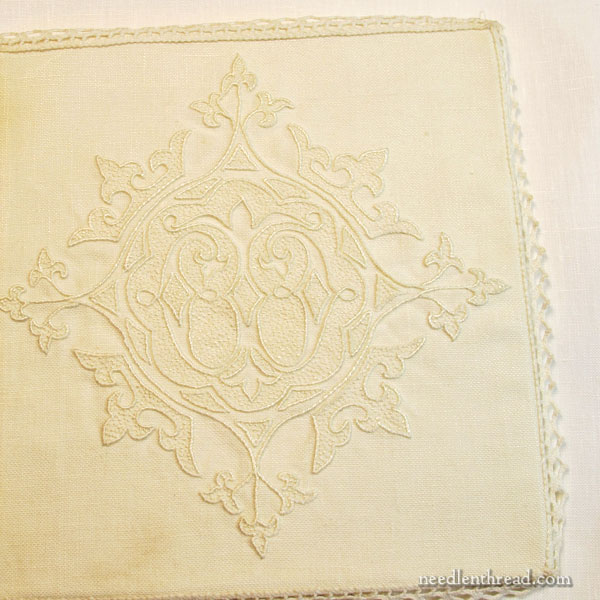
When we think about yellowed linen, usually we think in terms of “vintage” or “antique” linen. Fabrics – especially white fabrics that are sitting around in drawers or storage – tend to yellow over time, depending a lot on the environment they’re in, the way they’ve been used, and whether or not they were cleaned and stored conscientiously.
But with a piece of ecclesiastical linen like this, it does get used (I assume daily), and it doesn’t get cleaned very often. But it should get cleaned more often than this piece was cleaned, especially if it is used daily. Most small church linens, if cleaned regularly, don’t get into this shape.
I’ve explained before what a pall is, but to clarify for those who are just joining us on the subject, this type of pall is not to be confused with a funeral pall in liturgical services, although there is a symbolic connection between the two types of palls. This particular little square of linen is used to cover a chalice during the liturgy, for a very practical reason (it keeps things out of the wine).
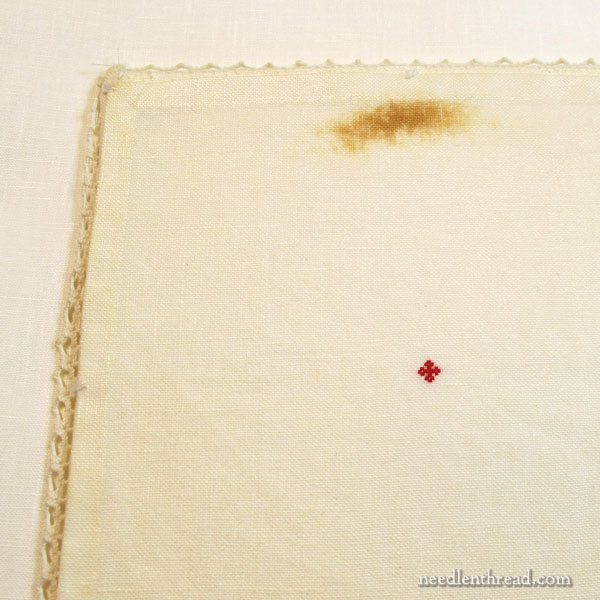
So it is not unusual for the linen that touches the edge of the chalice to get stained if there is any wine on the edge of the chalice.
This particular pall has an extra linen backing on it – a small, finished square of linen, hemmed, with a red cross embroidered in the middle, and which is tacked onto the back of the main “body” of the pall. The reason for this backing is that it can easily be removed and laundered and replaced, in case it gets stained. That plan didn’t work out so well.
Anyway, the pall came back to me for some attention, and I’m happy to see what I can do about getting back into usable shape.
I’m not trying to bring the linen to an optical white. It was not an optical white to begin with. It was a natural white. But I do want to lighten or eliminate the yellowing as much as possible and remove the stain completely.
As it is now, it is simply not usable. It is too yellow and too stained.
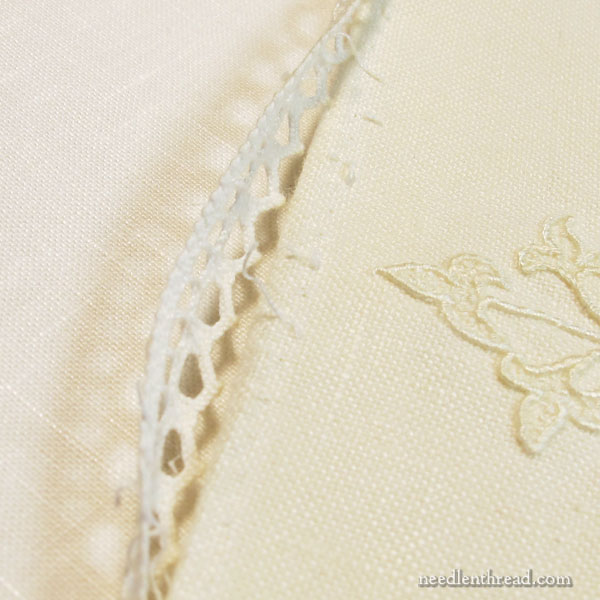
So my goal is to whiten it as much as I can, remove the stain, repair a little corner area where the original sewing has deteriorated a bit, and replace the lace.
I started by taking the whole thing apart: removing the linen square on the back, removing the lace (in the photo above, you can see the difference in the fabric where the lace was removed), opening the seam and removing the inside board.
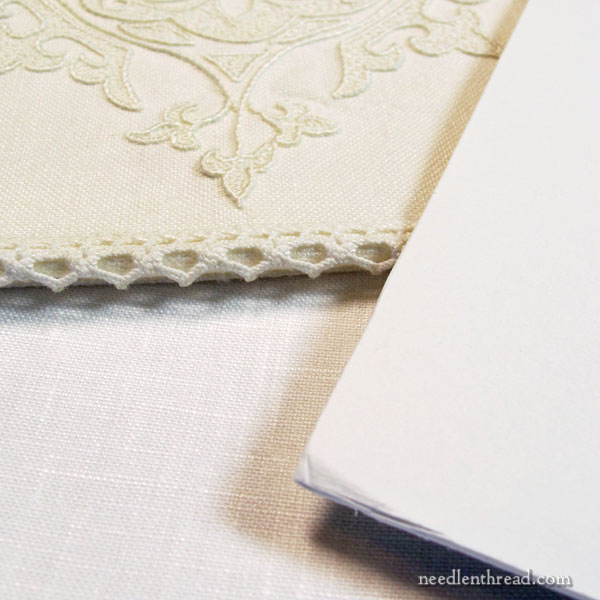
There’s a board (archival mat board) in the middle, that the linen encases in order to keep the pall stiff. The board is in pretty good shape, all things considered!
Still, I’ll replace the old one with a new one.
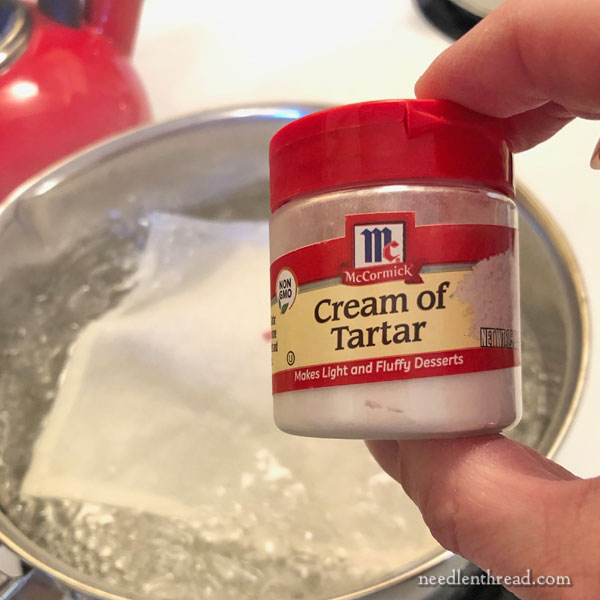
This is one of those situations where I will move from less aggressive methods of stain removal and cleaning to more aggressive.
Keep in mind that there are many ways to go about cleaning linens and other textiles and whitening old linens, and folks who do this kind of thing tend to have their favorite ways. In this article, I’m not demonstrating every possible way to do it. I’m just taking a series of steps to see if I can arrive at a usable level of cleanliness and whiteness.
When you’re working with linens that you’d like to save and be able to use, always start with the least aggressive cleaning methods and move to the more aggressive. While you don’t necessarily want to contribute to the quick deterioration of the fabric by using harsher chemicals, bleach, and the like, remember that if it can’t be used as is, it’s better to get aggressive and get it usable, if your plan is to use it. Otherwise, it just remains non-usable and it will deteriorate over time, anyway.
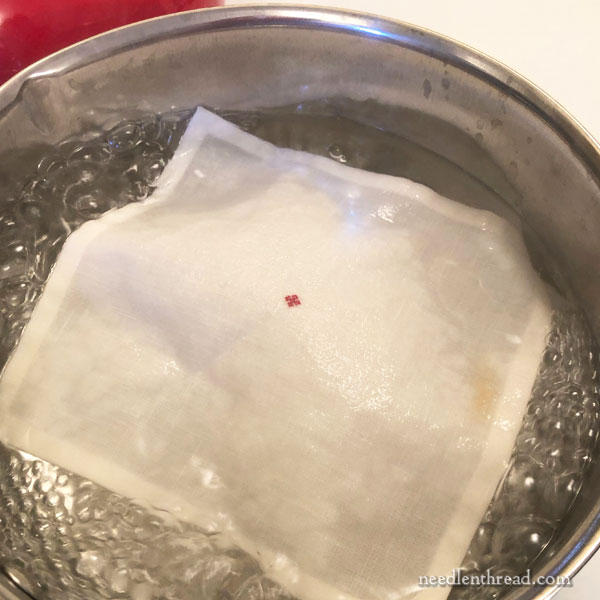
I started with my favorite method of cleaning stained smaller pieces of white linen. I boiled the linen pieces in water on the stove, adding cream of tartar to the boiling water.
After my standard ten minute boil, I checked progress, and I wasn’t impressed. The stain had lightened, but it was still there, and the yellowing was still problematic.
This method usually works very well with wine stains, but I suspect that it’s more effective on newer stains. This is an old stain.
So I left the linen to boil, refreshing the pot with water if the water line decreased too much, for about an hour
It didn’t make as much of a difference as I would like, so it was apparent that I would have to get more aggressive.
Time to bring on something acidic!
Good Thing I Don’t Have a Cat!
If you have ever seen the BBC’s delightful adaptation of Elizabeth Gaskell’s Cranford starring Judi Dench and other well-knowns, you might recognize my next method. If you haven’t seen it, I recommend it – and please do enjoy the scene where the cat drinks the buttermilk, along with the lace soaking in it, and ends up in the boot.
I’ve read in many old publications about using buttermilk to whiten linens. I’ve never actually tried it myself, but I figured why not? It’s a good opportunity to try it!
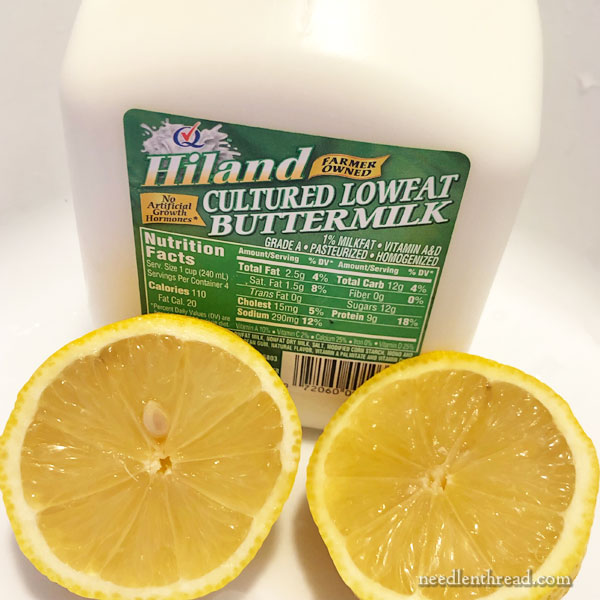
To prepare a buttermilk bath for soaking textiles, mix about a quart of buttermilk in a tub with a gallon of water, and squeeze in some fresh lemon juice (maybe a tablespoon or so). Stir it up and put your linen in to soak for 24 hours.
I did this.
It’s kind of disconcerting to see the separated buttermilk after 24 hours, with the buttermilk-coated linens languishing beneath the yellowy surface of the whey. The lemon is surely the culprit, since commercial buttermilk doesn’t usually separate to this degree at this speed.
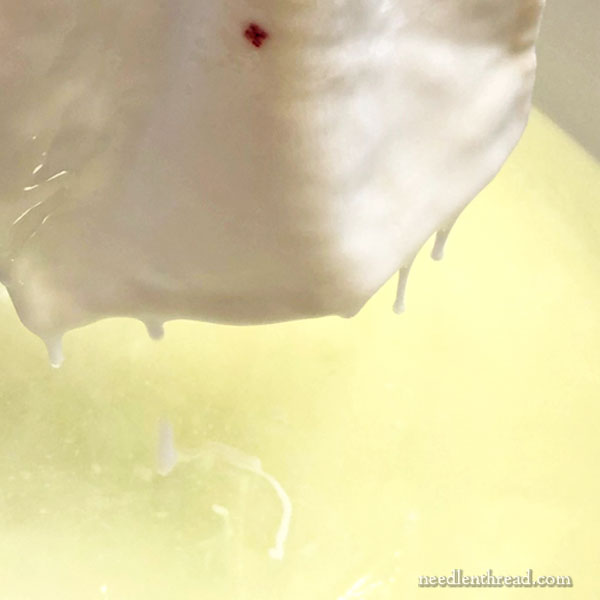
The linen was a bit gooey when I retrieved it.
It did lighten up considerably, and the stain faded considerably as well. Unfortunately, I forgot to snap a photo before I moved on to the next stage.
It’s not where I want it to be, so, after rinsing the linen thoroughly, I set it in a tub to soak overnight again in warm water with a little liquid Ivory detergent in it. This is just an in-between soaking stage, I’m sure. I just didn’t want the linen drying overnight. Today, I’ll examine the results of the buttermilk soak and the overnight Ivory soak a little more closely.
Never underestimate the power of soaking, by the way. Sometimes, you might have to soak a linen for 24, 48, 72 hours or more before you get the results you want. If you’re going to soak the linen for a long time, it is better to do so in a milder detergent, rather than in a harsher detergent. Usually, with the harsh stuff, you’re not going to need a super long soak, and harsher detergents can speed up the fabric deterioration.
I suspect that I will need to move on to at least one more stage, which is the stage where I use Biz, or perhaps Biz and Oxyclean.
Oxyclean will often do the trick, but use it with caution. If your embroidery is done with silk threads, avoid it. It’s not good for silk! It takes the natural sheen away and can even disintegrate the threads. The embroidery on this, I believe, is cotton. (I can’t remember absolutely!) I thought it was silk, but in going back through my notes, I see mention of “whitework threads.” If I had used silk, I would have said silk.
So that’s where I am now. I will keep you abreast of the outcome and the stages I take to get there!
Worst case scenario: I embroider a new one.
(Or is that the best case scenario?)
I’ll let you know!